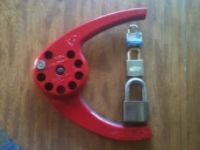|
THE starting place for new members. FAQ's, instructions on how to pick a lock, valuable information like product reviews, links to lock picking related sites, forum rules, lockpicking tool vendors, and more. START HERE.
 by PBYOcarrol » 26 Jan 2021 22:03 by PBYOcarrol » 26 Jan 2021 22:03
Hello Everyone,
I want to make my schlage mortise cylinder into a practise lock.
I want to eventually re-plug the tops of the pinstacks with hex grub screws for easy access and re-keying.
I’ve noticed a small thin plate running from front to back on the top of the core housing capping the pinstacks. I have no idea what this plate is called but I must have to remove it to get at the pinstacks from the outside. This is so I can thread the pin holes on the top of the cylinder.
Does anyone have an idea of how to remove this plate in a clean way?
Thx in advance.
-
PBYOcarrol
-
- Posts: 16
- Joined: 31 Dec 2020 16:53
 by GWiens2001 » 26 Jan 2021 23:19 by GWiens2001 » 26 Jan 2021 23:19
Put the mortise cylinder in a vise with that strip at the top. Take a new hacksaw blade (with sharp teeth) and place it flat on top of that strip with the teeth angled to grip towards the rear of the lock. Repeatedly tap the end of the blade down and towards the rear of the lock. That will have the teeth bite into that strip and drive it off the back of the lock.  You can also use an awl or pick to peel up the strip, but some locks don't take well to that. Gordon Just when you finally think you have learned it all, that is when you learn that you don't know anything yet.
-

GWiens2001
- Site Admin
-
- Posts: 7591
- Joined: 3 Sep 2012 16:24
- Location: Arizona, United States
 by Gantry » 27 Jan 2021 19:08 by Gantry » 27 Jan 2021 19:08
GWiens2001 wrote:Put the mortise cylinder in a vise with that strip at the top. Take a new hacksaw blade (with sharp teeth) and place it flat on top of that strip with the teeth angled to grip towards the rear of the lock. Repeatedly tap the end of the blade down and towards the rear of the lock. That will have the teeth bite into that strip and drive it off the back of the lock.  You can also use an awl or pick to peel up the strip, but some locks don't take well to that. Gordon
Wow, I guess you can teach an old dog new tricks! I have only done a few mortise cylinders but always did the "peel & strip" method. I'll give this a try my next time around! Thank GWiens
-
Gantry
- Supporter

-
- Posts: 151
- Joined: 19 Nov 2006 18:31
- Location: Ocala, FL
 by GWiens2001 » 27 Jan 2021 21:10 by GWiens2001 » 27 Jan 2021 21:10
Gantry wrote:GWiens2001 wrote:Put the mortise cylinder in a vise with that strip at the top. Take a new hacksaw blade (with sharp teeth) and place it flat on top of that strip with the teeth angled to grip towards the rear of the lock. Repeatedly tap the end of the blade down and towards the rear of the lock. That will have the teeth bite into that strip and drive it off the back of the lock.  You can also use an awl or pick to peel up the strip, but some locks don't take well to that. Gordon
Wow, I guess you can teach an old dog new tricks! I have only done a few mortise cylinders but always did the "peel & strip" method. I'll give this a try my next time around! Thank GWiens
Any time, Gantry.  I learn from people all the time, so am glad to pay it forward here. Gordon Just when you finally think you have learned it all, that is when you learn that you don't know anything yet.
-

GWiens2001
- Site Admin
-
- Posts: 7591
- Joined: 3 Sep 2012 16:24
- Location: Arizona, United States
 by stratmando » 27 Jan 2021 21:33 by stratmando » 27 Jan 2021 21:33
You can also use a follower, and pin, repin with tweezers, not bad practice.
-
stratmando
-
- Posts: 1224
- Joined: 26 Nov 2005 21:54
- Location: Florida Keys
 by PBYOcarrol » 28 Jan 2021 9:26 by PBYOcarrol » 28 Jan 2021 9:26
Thx, the hacksaw blade idea is great.
I’m hoping I can immediately tap a 6-32 thread into the pin stack without having to drill.
-
PBYOcarrol
-
- Posts: 16
- Joined: 31 Dec 2020 16:53
Return to Lock Picking 101 - FAQs, Tutorials, and General Information
Who is online
Users browsing this forum: No registered users and 2 guests
|




